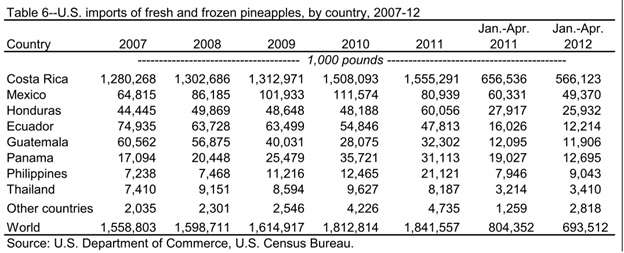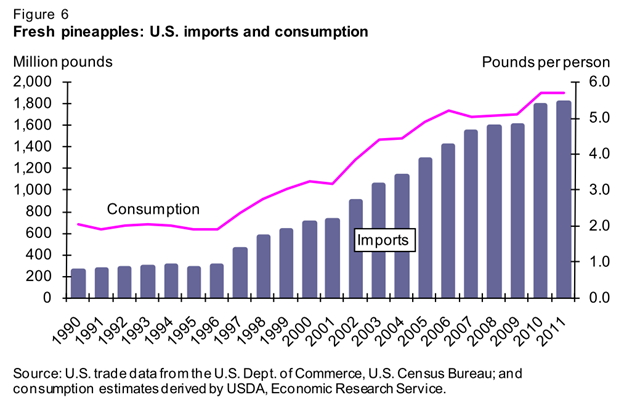-
Featured Posts
- St. Patrick’s Day Pineapple Punch
- Sheet Pan Perfect Pineapple Ham
- Can A Pineapple Really Live Under the Sea?
- Say Aloha to Our Hawaiian-style Ham and Pineapple Pasta Recipe
- Holiday Joy, Hanukkah, and Pineapple Kugel
- What are China’s Pineapple Science Awards?
- Fuel Up with Paleo Pineapple Fried Rice
- Best Gluten-Free Pineapple Upside Down Cake
- Piña Colada Pie in a Jar
- Slow Cooking Your Pineapple This Fall
Author Archives: admin
2013: Week 21 at the Source (Week 23 in the market)
– Rain: Week 21 at the source brought back some serious dry and hot weather. Except for a few days during the beginning of the week that registered precipitation of only 17.8 mm (close to 3/4 of an inch), the balance of the week was dry and sunny.
– Temperature: The air and soil temperatures increased. The average minimum air temperature reached 23.5°C (74.3°F) – 0.8°C higher than last week. The average temperature also increased to 27.5°C (81.5°F) – 1.4°C higher than last week, and the average soil temperature increased to 27.7°C (81.8°F). Solar radiation was intense and relative humidity was identical to last week – 84.3 %.
– Observations: There is no doubt that good weather conditions during this week and for the recent past, together with our conscious effort to increase harvest age, have played a significant role in the quality improvement that we see today. The percentage of NDF fruit being harvested is on the rise and will continue to be so for the next 6 weeks, but we are confident that our strict age control afforded by the colored ribbons will enable us to provide you with normal quality fruit during this usually challenging time frame.
Posted in Latest News, This Week at the Farm
2013: Week 20 at the Source (Week 22 in the market)
– Rain: Some very low intensity showers were recorded towards the end of Week #19 at the source. Total precipitation totaled 15.2 mm (0.60 inches) while dry and hot conditions prevailed.
– Temperature: Both the minimum and the average air temperatures dropped slightly during the week but the soil temperature remained stable. The average minimum air temperature reached 21.5°C (70.7°F) – 0.9°C lower than last week. The average temperature decreased to 26.9°C (80.4°F) but the average soil temperature continued stable at 27.4°C (81.4°F). Relative humidity continued low.
– Observations: The onset of a rainy period usually occurs by mid-May but seems to be delayed this year; a very positive turn of events because it will allow us to advance the many agricultural practices important to our crop and most importantly will allow us to continue to harvest the natural fruit with minimal quality concerns that are usually brought about by high precipitation.
Posted in Latest News, This Week at the Farm
2013: Week 19 at the Source (Week 21 in the market)
– Rain: Some very low intensity showers were recorded towards the end of Week #19 at the source. Total precipitation totaled 15.2 mm (0.60 inches) while dry and hot conditions prevailed.
– Temperature: Both the minimum and the average air temperatures dropped slightly during the week but the soil temperature remained stable. The average minimum air temperature reached 21.5°C (70.7°F) – 0.9°C lower than last week. The average temperature decreased to 26.9°C (80.4°F) but the average soil temperature continued stable at 27.4°C (81.4°F). Relative humidity continued low.
– Observations: The onset of a rainy period usually occurs by mid-May but seems to be delayed this year; a very positive turn of events because it will allow us to advance the many agricultural practices important to our crop and most importantly will allow us to continue to harvest the natural fruit with minimal quality concerns that are usually brought about by high precipitation.
Posted in Latest News, This Week at the Farm
2013: Week 18 at the Source (Week 20 in the market)
Rain: Dry and very hot conditions continued during week 18. Total precipitation was a mere 25.2 mm (1 inch), concentrated during the weekend so the rest of the week was incredibly dry!
Temperature: Both the minimum and the average air temperatures increased during the week but the soil temperature remained stable. The average minimum air temperature reached 22.4°C (72.4°F). The average temperature increased to 27.3°C (81.2°F) – 0.8°C higher than last week, but the average soil temperature continued stable at 27.3°C (81.1°F). Relative humidity was very stable at 84.3 % due to the low precipitation.
Observations: Weather conditions remained stable and well suited for the production of high quality fruit. Additionally, this is the period during which the farms take advantage of good weather and accelerate the process of soil preparation. The NDF harvest is taking place in a normal way and no quality problems are expected. A reliable source, who asked to be anonymous because they were not authorized to speak on the record, stated that volumes of Costa Rican pineapples will continue low and are expected to remain low over the next 8 to 10 weeks.
Posted in Latest News, This Week at the Farm
Pineapple Market Growth 2007-2012
Slow Start to Pineapple Imports in 2012
Combined U.S. imports of pineapple products (fresh and frozen, canned, and juice) during the first 4 months of 2012 fell 16 percent in volume from the same period a year ago. Imports were down for all three product categories. On a fresh-weight basis for comparison purposes, imports of pineapple juice during this 4-month period was down 27 percent from the same period last year, fresh pineapple down 14 percent, and canned pineapple down 8 percent. On average, fresh (including frozen) pineapples account for the largest share of total annual import volume with around 40 percent, while pineapple juice and canned pineapples make up almost equal shares of around 30 percent.
Reduced U.S. imports of fresh pineapples (includes frozen) in 2012, January through April, are impeding fresh pineapple domestic consumption as imports make up a majority of total fresh pineapple supplies in the U.S. market. U.S. imports to date in 2012 from most leading countries supplying fresh pineapples to this market posted volume declines, including Costa Rica—the No. 1 source with over 80 percent of the annual total on average (table 6). Cool weather and heavy rains in late 2011 hampered pineapple production in Costa Rica, causing January-April shipments to the United States to drop 14-percent below the same time last year. Despite this temporary supply disruption, industry sources indicated that with current improved weather, the pineapple crop in Costa Rica will produce ample promotable fruit this spring and summer. Major import suppliers in Latin America also shipped reduced volumes to the United States in January-April 2012. At the same time, imports from key suppliers in Southeast Asia—the Philippines and Thailand—were higher than a year ago.
Consecutive year-to-year increases in fresh pineapple imports over the past 16 years helped support the growing demand for fresh pineapples in the United States. Fresh imports increased six folds during this 16-year span, reaching a record 1.8 billion pounds in 2011(fig. 6). Production in Costa Rica recovered from a slow start in 2011 due to cold weather, sending off a total of 1.6 billion pounds to the U.S. market last year, up 3 percent from the previous year and more than making up for big import declines from most of the other major suppliers. Total 2011 imports were up 2 percent from the previous year, providing ample supplies for domestic use. While fluctuating each month throughout the year, U.S. pineapple retail advertised prices in 2011 averaged relatively unchanged from the 2010 average price of $3.00 each, based on AMS data. U.S. fresh pineapple per capita use was estimated at 5.7 pounds in 2011, maintaining the record set the previous year.
(click charts to enlarge)
Should overall imports return to near or above year-ago levels through the remainder of 2012, current domestic demand levels should be sufficiently met, likely leading to reasonable prices to consumers and an increase in domestic fresh pineapple per capita use. For this year through June, U.S. pineapple retail advertised prices have averaged about 1 percent lower than the same period a year ago.
Lower U.S. imports of canned pineapples during the first 4 months of 2012 reflect reduced volumes from top supplying countries, except for Vietnam which registered more than a three-fold increase to date from the same time last year (table 7). The magnitude of declines from major suppliers, Thailand, the Philippines, Indonesia, and Malaysia, ranged from 1 percent to 10 percent, and was much more pronounced from China, down 51 percent. At the same time, juice imports from top Southeast Asian suppliers—the Philippines, Thailand, and Indonesia—were down by as much as 34 percent to 50 percent, outweighing at least a doubling in imports from Costa Rica and Kenya and a very steep rise from Brazil (table 8).
Like in the fresh market, imports mostly supply the demand for these products in the United States. Canned pineapple imports trended slightly up over the last 16 years while pineapple juice imports remained mostly flat, a reflection of domestic demand. Rapid growth in the fresh market is reflected in fresh pineapple imports surpassing those for canned during the past 6 years and those for juice since 2004. Together, pineapples in canned and juice form account for most pineapples available in the United States, on a per capita fresh-weight basis, but Americans are now eating more pineapples in fresh form than in canned and juice separately—a reverse of the situation prior to 6 years ago.
Works Cited
Perez , Agnes, and Kristy Plattner . “Fruit and Tree Nuts Outlook.” USDA United States Department of Agriculture. N.p., n.d. Web. 22 Oct. 2012. <www.ers.usda.gov/media/826893/fts352.pdf>.
Posted in Featured, Latest News
2012: Week 37 at the Source (Week 39 in the Market)
- Rain: Precipitation increased significantly during week 37 with 76.8 mm ( 3 inches) of rainfall registered at the farms. Days were mainly cloudy and wet throughout the week.
- Temperature: Both air and soil temperatures decreased. The average minimum temperature was 23 Celsius degrees (73.5 F) and the average weekly temperature was 27.2 Celsius degrees (80.9 F). Average soil temperature registered 27.1 Celsius degrees (80.9 F) and the relative humidity increased very slightly to 84.4 %. Solar radiation was low as most days were cloudy.
- Observations: Climate changed dramatically during the second week of September.
Posted in Latest News, This Week at the Farm
Oriental Chicken, Peppers, and Rice
Here’s a great way to use pineapple for a little Asian fusion! Thanks again Pineapple Pete.
Recipe By: Jo Anne Merrill
Serving Size: 4
Preparation Time: 0:30 Minutes
Ingredients:
3 Chicken Breast Halves
2 Garlic Cloves – Minced
1 Onion – Minced
1 Red Pepper – Julienned
1 Green Bell Pepper – Julienned
1 Tablespoon Cornstarch
4 Tablespoons Soy Sauce – Low Sodium
8 Ounces Pineapple Chunks in Juice – 1 Can
2 Tablespoons Vinegar
3 Tablespoons Packed Brown Sugar
1/2 Teaspoon Ginger
2 Cups Cooked Rice
* Use 3 chicken breast halves to yield about 4 servings. Use more chicken for larger portions.
PREPARATION:
1. To prepare chicken: skin, debone and chop into cubes.
2. Mince the garlic cloves.
3. Wash, seed and julienne the red and green peppers.
4. Do not drain the pineapple.
5. Heat a heavy skillet; add 1 tablespoon oil. Saute the peppers, garlic and onion until onion is limp. Remove from skillet and keep warm.
6. Add 1 tablespoon oil to skillet and cook chicken cubes until all turn white and are cooked through. This step doesn’t take long. Don’t overcook.
7. Mix cornstarch with soy sauce and some of the pineapple juice in a small bowl.
8. Combine the chicken with the onion mixture. Add the pineapple chunks and juice along with the brown sugar, vinegar and ground or freshly grated ginger. Heat to boiling, then add the cornstarch mixture. Stir constantly until sauce is thickened and heated through.
9. Serve immediately over hot cooked white rice.
Enjoy,
Dr. Lloyd
Posted in Recipes
Week 3 At The Source
Total rainfall during week #3 was only 18.4 mm – less than a inch and concentrated at the beginning of the week. Low rainfall and high solar radiation were the positive weather variables of the week but low air and soil temperatures continued – meaning that the risk of a stressed induced event of NDF is something that should not be ruled out yet. As scheduled, the farms have began during week #3 identifying the first two events of naturally differentiated fruit that occurred during W46-47 and W48-49. This practice, although labor intensive and costly in itself, will bring definite benefits at the time of harvest. One of the major concerns at harvest time is determining the chronological age of the fruit specifically in fields affected by events of “natural fruit”. One can easily conclude that if we harvest and pack fruit of different ages, we would end up with very extremes of maturity in a box. This was indeed a major problem in years past before we adopted this practice. Now with this identification process, we have improved our quality during these challenging times by assuring the harvest of similar age fruit during the harvest week.
Posted in Latest News
Week 2 At The Source
A real roller coaster of a ride is the best way to describe our weather in the Caribbean coast of Costa Rica – this week 02, a total of 1 mm of rain was reported which compared to prior week is quite dramatic. While the weather had a very positive change in terms of lower precipitation and more solar radiation a decrease in our minimum temperature may bring an increase in the risk of a new event of NDF. So far we have identified four NDF events, starting on W46-47 continuing on W48-49 and W50-51 of 2011 and another event on week 01/2012. This possibility of another event on W02 would be considered as a continuation of the event identified in W01/2012. Based on the climatic variables we monitor and believe are the primary causes of plant stress we conclude that events W50-51/2011 and W01-02/2012 have been the most severe so far. The farms are planning to start the identification program of the “natural” fruit next week using different ribbon colors to identify each event..
Posted in Latest News
Hawaiian Kebabs
INGRIEDIENTS:
1 Pound of Chicken Breasts
1 Pineapple in Rings – Canned
3/4 Ounces of Fine Cheese – Chilled (Jarlsberg, Emmenthal or Equivalent)
2 Teaspoons Sunflower Oil
1 Garlic Clove – Crushed
1 Teaspoon Lemon Juice
1/2 Teaspoon Nutmeg
Salt and pepper
PREPARATION:
1. Cut chicken breasts in cubes of equal sizes for sticks.
2. In the large pot put water to boil, add the pork and boil it for another 5 minutes.
3. Remove the pineapple from the can and save 3 tablespoons of juice from the can.
4. Cut the Pineapple and cheese into cubes of equal size as you did with the meat.
5. Make marinade of pineapple juice, oil, lemon juice, garlic, nutmeg and pepper.
6. Take meat out of the water and make sticks alternately putting meat, pineapple and cheese.
7. Bake at medium heat, turning it every 2-3 minutes and abundantly spreading with marinade.
8. Bake on each side for 2-3 minutes until pineapple and meat be-comes hot and cheese starts to melt.
Enjoy,
Dr. Lloyd
Posted in Recipes




